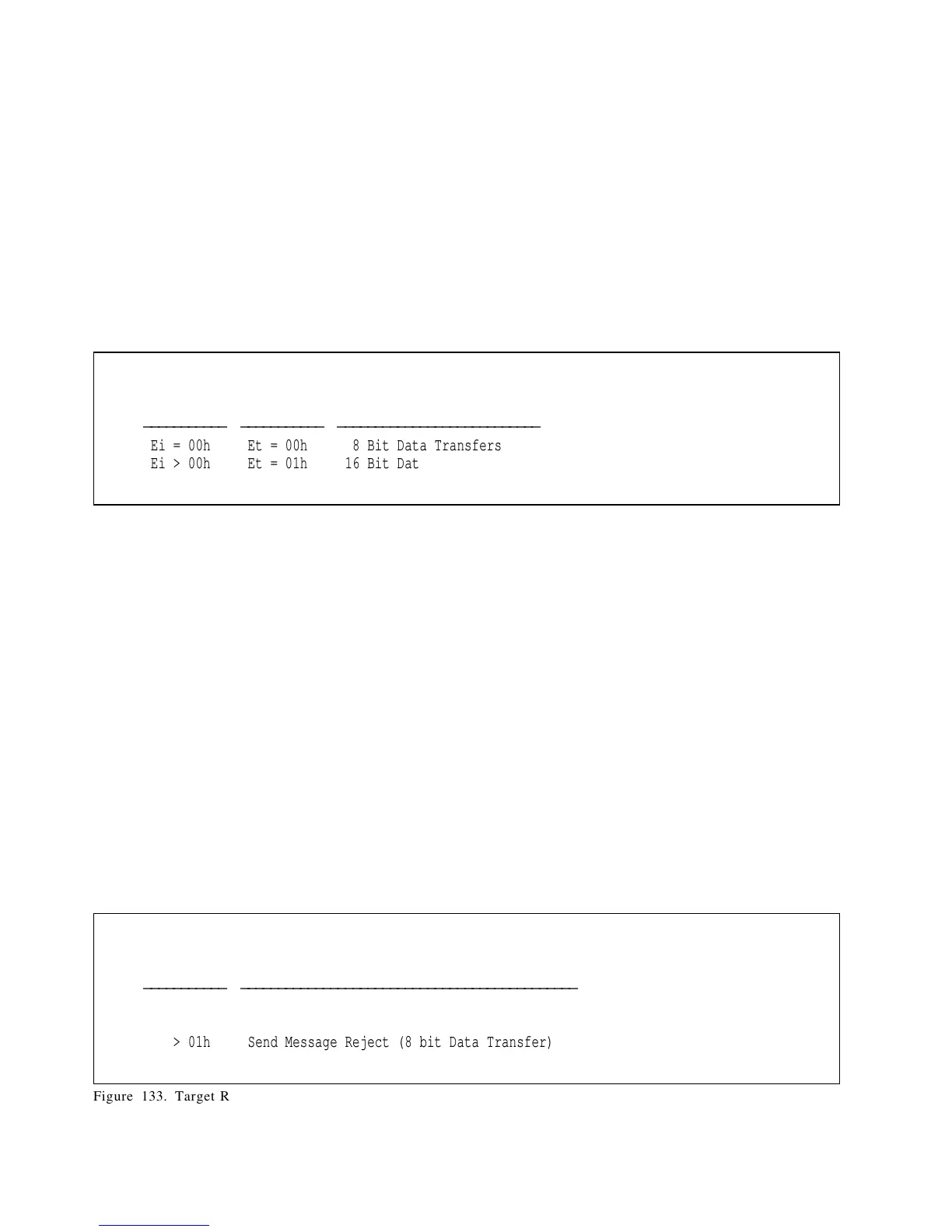E The Transfer Width Exponent (E) is two to the transfer width exponent bytes wide. Valid data
transfer widths are 8 bits (E = 00h) and 16 bits (E = 01h). Value of E greater than 01h are
reserved.
9.1.3.1 Transfer Width Negotiation Started by the Initiator
If the Initiator recognizes that negotiation is required and sends a Wide Data Transfer Request message out,
the Target responds by changing to the Message In phase and sending a Wide Data Transfer Request
message in to the Initiator prior to transfer any additional message bytes (or any other Information phase
bytes) from the Initiator. This provides an interlock during the data transfer width negotiation.
The Drive responds to each Initiator requested transfer width exponent as shown in the following table.
Target
Initiator Target Data Transfer
Request Response Width
ÄÄÄÄÄÄÄÄÄÄÄ ÄÄÄÄÄÄÄÄÄÄÄ ÄÄÄÄÄÄÄÄÄÄÄÄÄÄÄÄÄÄÄÄÄÄÄÄÄÄÄ
Ei = 00h Et = 00h 8 Bit Data Transfers
Ei > 00h Et = 01h 16 Bit Data Transfers
Figure 132. Initiator Request/Target Response
If following the Target's response above the Initiator asserts the ATN signal and the first message received is
either a Massage Parity Error or a Message Reject message, the Target negates the data transfer width agree-
ment and goes to 8 bits mode. For the Massage Parity Error case, the implied data transfer width agreement
is reinstated if the Target successfully retransmits the Wide Data Transfer Request message to the Initiator.
For any other message, the Target completes negotiation and goes to the negotiated data transfer width.
9.1.3.2 Transfer Width Negotiation Started by the Target
If the Target recognizes that negotiation is required, the Target sends a Wide Data Transfer Request message
to the Initiator with the transfer width exponent equal to 1 (E = 01h). The Initiator must respond by
asserting the ATN signal prior to its release of ACK for the REQ/ACK handshake of the last byte of the
Wide Data Transfer Request message. This provides an interlock during the wide data transfer negotiation.
If the Initiator does not assert the ATN signal, the Target goes to 8 bit mode. If the Initiator does assert the
ATN signal, the Target changes to the Message Out phase and receives a message from the Initiator.
If the first message received is a Wide Data Transfer Request message, the Target establishes the new data
transfer mode. The Drive interprets the Initiator corresponding transfer width exponent as shown in the
following table.
Target
Initiator Data Transfer
Request Width
ÄÄÄÄÄÄÄÄÄÄÄ ÄÄÄÄÄÄÄÄÄÄÄÄÄÄÄÄÄÄÄÄÄÄÄÄÄÄÄÄÄÄÄÄÄÄÄÄÄÄÄÄÄÄÄÄÄ
Ei = 00h 8 Bit Data Transfers
Ei = 01h 16 Bit Data Transfers
Ei > 01h Send Message Reject (8 bit Data Transfer)
Figure 133. Target Request to Initiator
168 OEM Spec. of DDRS-3xxxx

